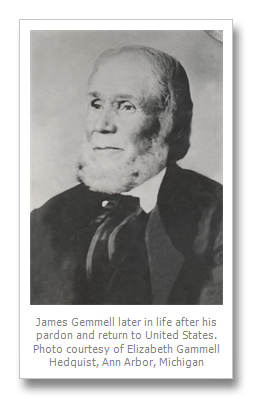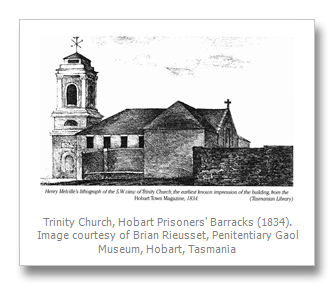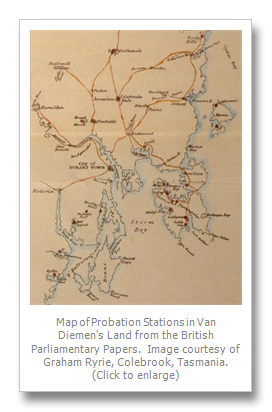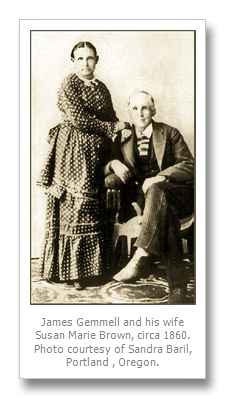Written by
John C. Carter posted on August 13, 2010 22:24
Readers of TIL are aware that one hundred and sixty Patriots were taken prisoner at the Battle of the Windmill near Prescott in 1838. They might not be as familiar with the other political prisoners captured at three other incursions during the Patriot Wars. One of these men was James Gemmell.
Gemmell (also spelled Gammell) was born on October 16, 1814 in Kilmarnock, Scotland. As a child he emigrated with his family to New York City. Around 1830, Gemmell moved from the United States and re-located in the Gore District of Upper Canada. There he became increasingly frustrated with the bureaucratic control of the colonial administration of Upper Canada. He supported the Patriot cause along the American/Canadian frontier which among other things called for political and economic change. Gemmell joined the Niagara rebels and participated in the Short Hills skirmish at St. Johns in Upper Canada in June 1838.

Following his capture and subsequent trial and conviction, Gemmell and his companions were incarcerated in Montreal and then moved to the Old City Jail in Quebec. Then Gemmell was placed aboard the Captain Ross for a voyage to Liverpool with twenty-two other political prisoners from the Toronto uprising and the Shot Hills invasion. Exile narratives by Benjamin Wait and Linus Miller describe this voyage. On arrival in Liverpool, several of the prisoners were sent to London for trial in the Court of the Queen's Bench. Gemmell and others were taken to Portsmouth and held aboard the prison hulk York. Their stay in England ended in September 1839 when Gemmell, Linus Miller, John Grant and Jacob Beemer were loaded on the convict transport Canton enroute to the penal colony of Van Diemen's Land.

The prisoners arrived in Hobart Town in January 1840 and joined other North American political exiles who had departed previously aboard the Marquis of Hastings. After a month's confinement at the Hobart Prisoners' Barracks, Gemmell and his colleagues were sent to the Brown's River Probation Station to cut, trim and shape trees as ships' spars. Laterally Gemmell and his other conspirators were transferred to the nearby Sandy Bay Probation Station. Here they joined fellow Patriots who had recently arrived from Quebec aboard the HMS Buffalo. It is likely that James Gemmell remained as a probationary gang labourer from May 1840 until the beginning of 1842. During this period he was stationed at Lovely Banks, Green Ponds (now Kempton), Bridgewater and finally Rocky Hills probation stations.
Gemmell received probation through the issuance of a ticket of leave which was announced on January 28, 1842. This allowed him and other Patriots to seek individual wage work. He found employment at Swansea on the east coast of Van Diemen's Land. During a visit to Hobart Town, Gemmell eluded his captors and made his escape to freedom aboard an American whaling ship. He eventually arrived in New York City where his return was detailed in an article published in the morning edition of the June 24, 1842 New York Herald. While in New York, Gemmell made contact with the former Upper Canadian rebel leader William Lyon Mackenzie. The two collaborated on a lengthy description of Gemmell's involvement in the rebellion, his capture and resulting exile. These accounts were published as letters to the editor in the June 25 and 28, 1842 editions of the New York Plebeian.
Gemmell's remembrances were essentially accurate when comp

ared to other Patriot diaries and narratives which were issued later in book form. Gemmell's memoirs are important because they were some of the first to be published and widely distributed in the popular press. His stories were re-printed in other New York papers including the Watertown Register, Ogdensburg Republican, Brooklyn Eagle, St. Lawrence Republican, and Plattsburg Republican. These articles would have been avidly read by relatives of the North American political prisoners who had been captured at the Battle of the Windmill, and who were compatriots of James Gemmell. Residents of New York counties bordering Lake Ontario and the St. Lawrence River thirsted for knowledge about the fate of their loved ones who still remained in Van Diemen's Land. Gemmell's reflections would help fill this void.
Gemmell remained in New York City for a week before journeying northwards to visit with friends in Upper Canada. Within a year of his arrival back on American soil Gemmell settled in Detroit, married and fathered a number of children. In the early 1840s he travelled to Oregon and spent several years there. In 1847 he returned to Michigan to bury his first wife Harriet. In the summer of 1847, James Gemmell travelled to Salt Lake City. He embraced the westward expansion in the United States, joining this movement and taking an active part in the exploration and the development of the American western frontier during the mid-nineteenth century. His western sojourn depicted a mini-historical catalogue of events which helped to shape the ever westward expanding American frontier. Especially noteworthy was his relationship with Brigham Young and the Mormon Church in Utah. His equivocal conversion to the Mormon faith involved him in the issues and arguments surrounding the church versus federal authority including the much disputed Mountain Meadows Massacre in 1857.

Gemmell assimilated into Mormon society, accepted polygamy and other elements of this religious community's structure, yet he continued to travel to distant destinations in the American West, exploring, guiding surveyors and trading with miners and Indians. He died on April 6, 1881 near Sheridan, Montana. This ended the fascinating story of James Gemmell, a Patriot survivor and man of two frontiers.
By John C. Carter
Dr. John C. Carter is an authority on the subject of the Rebellion of 1837-38. He received a B.A. in History and MA in Native Studies from the University of Waterloo. He then received a Bachelor of Education in Library and History at University of Western Ontario and completed his Doctorate in Museum Studies from the University of Leicester, in England. Today John is a Museum & Heritage Advisor for the Ontario Ministry of Culture and lives in Toronto. In October 2009 he was the guest editor of “Ontario History”, the Journal of the Ontario Historical Society. John can be contacted at drjohncarter@bell.net.
Additional Reading:
Colin K. Duqemin, Niagara Rebels: The Niagara Frontier in the Upper Canada Rebellion 1837-1838 (St. Catharines: Norman Enterprises, 2001)
Alfred A. Fry, A Report of the Case of the Canadian prisoners; with an Introduction on the Writ of Habeas Corpus (London: A. Maxwell, 1839)
Elizabeth Gammell Hedquist, "The James Gammell Chronicles," Google Elizabeth Gammell Hedquist
Linus B. Miller, Notes of an Exile in Van Diemen's Land (Fredonia, N.Y. : W. McKinstry, 1846)
Stuart D. Scott, "A Frontier Spirit: the Life of James Gemmell," Australasian Canadian Studies Journal (2007), v. 25, pp. 55-115
Benjamin Wait, Letters From Van Diemen's Land (Buffalo: A.W. Wilgus, 1843)